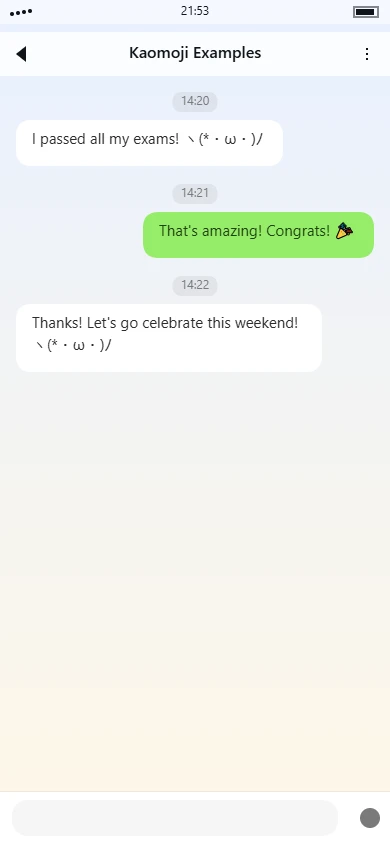(*´▽`*) kaomoji meaning | usage tips

Overview
This kaomoji (´▽`) presents a stylized facial expression that conveys a sense of happy contentment with a touch of shyness. The composition uses a combination of parentheses, apostrophes, and katakana characters to create a rounded, soft-looking face with distinct facial features.
Visual Structure Explanation
The kaomoji is structured with parentheses forming the outer boundaries of the face, creating a rounded shape that suggests a full, cheerful expression. Inside these boundaries, the facial features are arranged in a balanced manner. The eyes are represented by asterisks (*) positioned at the upper left and right corners, giving the impression of closed or happily squinted eyes. Between them sits the katakana character ▽ (sankaku), which serves as the mouth or nose element. This triangular shape points downward, creating a gentle smiling effect when viewed within the context of the overall face.
The apostrophes (´ and `) flanking the ▽ character add subtle details to the expression. These diacritical marks curve slightly outward, suggesting rosy cheeks or additional facial contours that enhance the blushing, contented appearance. The entire composition has a symmetrical quality that contributes to its balanced, pleasant visual effect.
Symbol Breakdown
- Parentheses ( ): Form the outer contour of the face, creating a rounded shape that suggests fullness and cheerfulness
- **Asterisks ***: Positioned as eyes, representing closed or happily squinted eyes common in expressions of contentment
- Katakana ▽ (sankaku): Serves as the central facial feature, with its downward-pointing triangle shape creating a gentle smile
- Apostrophes ´ `: Flank the ▽ character, adding subtle facial details that suggest cheeks or additional contours
- Combined arrangement: The elements work together to create a cohesive facial expression with balanced proportions
Emotion & Aesthetic Analysis
This kaomoji primarily conveys a sense of happy contentment with subtle shy undertones. The closed eyes suggest a state of blissful satisfaction, while the downward-pointing triangle mouth creates a gentle, restrained smile rather than an exuberant one. The overall effect is more subdued than kaomoji with wide-open eyes or upward-curving mouths.
The aesthetic leans toward kawaii (cute) culture influences, with its rounded forms and soft features. Compared to similar kaomoji like (´∀`) or ( ̄▽ ̄), this version has a slightly more contained, personal feeling due to the closed eyes and the specific placement of the apostrophe details. It's well-suited for expressing quiet happiness, mild embarrassment, or contented approval in digital communication.
Tag categories
Use tags to quickly understand this kaomoji.
Emotion tags
Object tags
Click tags to explore related kaomoji.
Usage guide
Usage Guide for (´▽`)
This charming kaomoji, with its starry eyes and cheerful mouth, is one of the most versatile and beloved expressions in Japanese-style digital communication. It captures a unique blend of happiness, excitement, and adorable embarrassment that makes it perfect for conveying warm, positive emotions in casual online interactions. The expression radiates a genuine, almost giddy joy that's infectious yet gentle—imagine someone blushing while smiling ear to ear, or a character in an anime getting overwhelmingly happy about something small but meaningful. You'll commonly see this kaomoji in friend chats, social media comments, gaming communities, and anywhere people want to add a touch of kawaii (cuteness) to their messages.
Common Use Cases
- Expressing delight when receiving unexpected compliments from friends
- Reacting to cute animal videos or pictures shared in group chats
- Showing happy embarrassment when someone points out your small achievements
- Celebrating minor victories in mobile games or completing daily tasks
- Responding to kind messages from online friends in Discord servers
- Adding warmth to thank-you messages for small favors or gifts
- Sharing excitement about upcoming anime episodes or manga releases
- Reacting to funny memes that hit just the right note of humor
- Expressing genuine happiness when plans with friends work out perfectly
- Showing appreciation for comforting words during mildly stressful times
- Celebrating when your favorite streamer achieves something special
- Adding positive energy to casual conversations in online communities
Example Conversations
-
Friend chat about plans Person A: "Hey, I managed to get tickets for that concert you wanted to see!" Person B: "No way! Really? (´▽`) I can't believe you remembered!"
-
Gaming community interaction Player A: "Just helped a new player complete their first dungeon" Player B: "That's so sweet of you! The community needs more people like you (´▽`)"
-
Social media comment exchange Post: "Made cookies for the first time today!" Comment: "They look absolutely delicious! Could you share the recipe? (´▽`)"
-
Casual compliment response Person A: "Your new profile picture is really cute!" Person B: "Aww thank you! (´▽`) I was a bit nervous about changing it"
-
Sharing good news Person A: "I finally finished that project I've been working on for months" Person B: "Congratulations! You must feel so relieved and proud (´▽`)"
-
Online shopping excitement Person A: "The package you wanted is finally back in stock!" Person B: "Yay! Ordering it right now! (´▽`) Thank you for letting me know!"
Important Notes
- Avoid using this kaomoji in professional emails, formal business communications, or serious discussions where its playful tone might undermine your message's importance
- While generally positive, the expression's extreme cuteness might occasionally come across as insincere or sarcastic if used in response to genuinely serious situations
- The kaomoji works best in communities familiar with Japanese internet culture—some people outside these circles might find it confusing or overly exaggerated
Platform Tip: This kaomoji is particularly popular on platforms like Discord, Twitter, and gaming forums where cute expressions are widely appreciated and understood. It pairs well with other kawaii elements but can stand strong on its own to convey genuine happiness.
Usage examples
Real conversation samples that feature this kaomoji.

Example 1

Example 2
Related kaomoji
You might also enjoy these kaomoji.